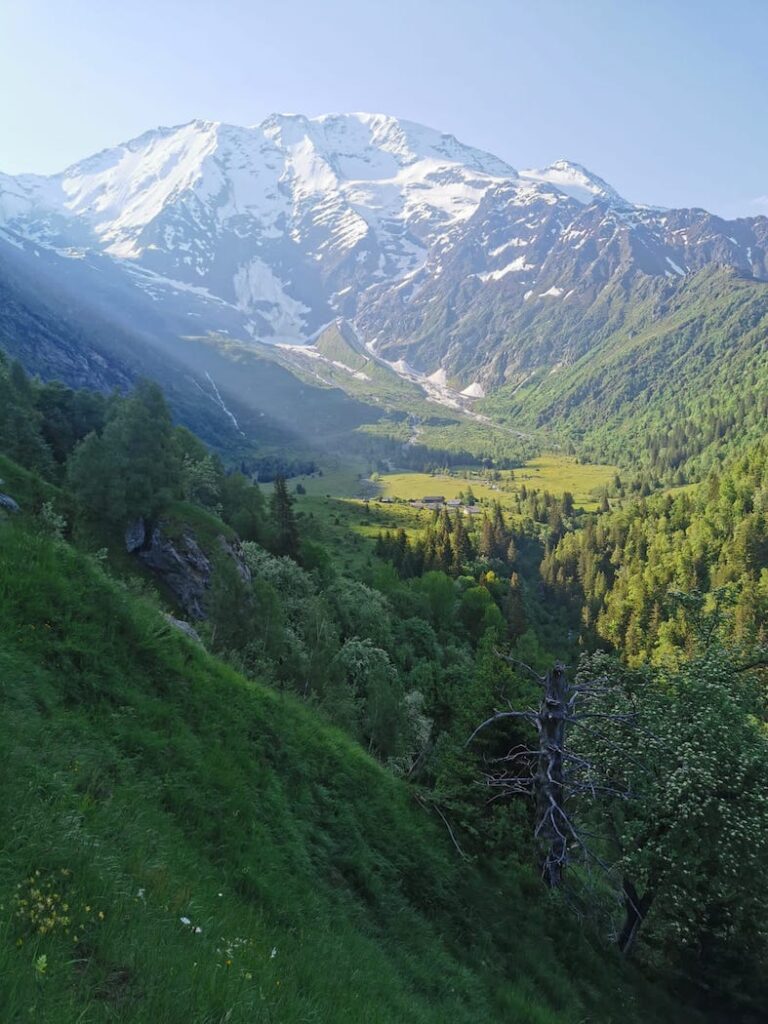Tour du Mont Blanc: Trekking, packing list, self care and preparation
Embarking on the Tour du Mont Blanc, whether trekking or trail running, promises a deeply rewarding experience—immersing yourself in nature and pushing your boundaries. Prioritising self-care is essential to fully enjoy the journey while minimising the risk of injuries or discomfort.
Whether you have been training hard beforehand, or if you wish you had… there are bound to be moments when the going gets tough. Self-care on the trails can be an essential way to reduce daily aches and pains, prevent injury and even tiredness.
Ideally you will have done some training before your TDMB trek. Even still, your body will be exposed to new stresses and strains so it will need to adapt and recover on route to become fitter stronger and more resilient.
However, as the days pass by on your trek, you may well find you feel aches and pains or physical stress, all of which you would like to push on through. Practising self-care on your route is a must do, to provide relief, prevent injury, and promote recovery after each day on the trail.
Drawing on experience in trekking and camping over the years, I’ve gathered insights and practical advice for multi-day hikes on this iconic trail. From trekking self care and preparation to thoughtful packing strategies, these tips aim to enhance your preparation and overall enjoyment of the Tour du Mont Blanc. By embracing self-care principles and packing carefully, you can embark on this journey with confidence, ready to embrace the challenges and rewards that await along the way.

Trekking Rucksack
Your trekking rucksack should really be no more than 10kg. Our packing list includes gear, refuge essentials, safety items, and first aid supplies. It is a good idea to try and use lightweight gear to reduce your load, especially given the elevation gains on challenging trails. When you’re climbing your second 1000m pass in a day, you’ll be grateful for a lighter pack.
Some trekkers use luggage transfer services to handle heavier bags. While this allows for more luxurious packing, not all remote areas are accessible by vehicles, so you’ll sometimes need to rely solely on your day pack. Additionally, luggage transfers can be costly
Make sure you rucksack has a waist support, so you are not carrying all the weight on your shoulders.
Also small pockets on the straps where you can put easy access items- snacks, water, phone etc.
Some come with rain covers too, which are a useful addition.
Try it out first on hikes before your long trek to check it for comfort and size.
Trekking self care hygiene
- Biodegradable soap, a small towel, and hand sanitizer. Use natural water sources for washing, and practice Leave No Trace principles to minimize environmental impact.
- Toothbrush, lip salve (SPF 50+), suncream (SPF 50+) deodorant, travel shampoo
- Socks: Invest in high-quality wool blend socks and pack enough pairs to ensure you have a clean, dry pair every day. If you’re doing a long trek, you’ll need to wash some along the way, but make sure you have at least 4-5 pairs. Keeping your feet dry and warm is crucial for preventing blisters, which you definitely want to avoid. Change your socks daily to prevent blisters and fungal infections. Bring a small foot powder or balm to keep your feet dry and comfortable.
Rest
Having a good night sleep is crucial for trekking, as it affects mental and physical performance, energy levels and mood.
Many things can disrupt sleep while hiking, there are definitely things one can do to aid sleep on the trail. These include CBD drops, earplugs, deep breathing and making sure you’ve kept yourself well hydrated during the day.
Tent: Select a tent that’s as lightweight as possible, considering you’ll be carrying it for 8-10 hours each day. It should also be durable and capable of withstanding harsh weather conditions.
- Sleeping bag: Invest in a good quality sleeping bag appropriate for the season and a lightweight, comfortable sleeping pad.
- Silk liner. Many refuges require you to use a liner. It adds warmth to your sleeping bag without adding weight, wicks away moisture for added comfort, and is easy to wash and dry. This lightweight, versatile item improves hygiene and extends your sleeping bag’s lifespan, making it an essential piece of gear.
- Sleep routine: Set up camp at least an hour before sunset to allow ample time for rest. Establish a routine that includes relaxing activities like reading or gentle stretching to wind down.
Poles for the Tour du Mont Blanc
Taking trekking poles on a hike is highly beneficial.
They provide extra stability on uneven terrain, reducing the risk of slips and falls. Poles also help distribute the effort more evenly across your body, reducing strain on your legs and knees, especially during steep ascents and descents.
By engaging your upper body, trekking poles can help improve your posture and overall endurance, allowing you to hike longer and more comfortably. Additionally, they can be used to test the stability of the ground ahead and for balance when crossing streams or navigating rocky paths. Overall, trekking poles are an essential tool for enhancing safety, comfort, and efficiency on the trail.

Trekking self care massage and recovery
Self massage is an all-around winner for recovery at the end of the day to loosen tight muscles, relieve discomfort and promote circulation.
Self-Massage Tools: Pack a small, lightweight massage ball or roller. Apply pressure slowly to your muscles working with there over your feet shins and thighs and glutes. If you have tightness spend extra time to release tightness.
Pack a small, lightweight massage ball or roller. Use these to target sore muscles
Recovery Balm: Bring a recovery balm for muscle relief. Apply it to areas prone to tension after long days of hiking. This will really help you to feel on good form for the following day.
Nutrition
Food: Plan meals that provide a balance of carbohydrates, proteins, and fats. Snacks to take each day like nuts, seeds, and dried fruits are excellent options.
Hydration: When water supply is scarce it is easy to forget to drink water, yet it is vital. Not drinking enough water leads to dehydration, which effects mental performance, decision-making and bodily functions.
I advise filling up your full bottle routinely at each water source, and adding some flavor or electrolytes.
Clothing
Layering is crucial for staying comfortable on the Tour du Mont Blanc. It offers versatility, letting you adjust to changing weather conditions. Ensure you have insulation, ventilation, and wet weather protection while keeping weight to a minimum.
- Layering Dress in layers, including a base layer, an insulating layer, and a waterproof outer layer. I always carry a set of thermal clothing as a backup—they’re lightweight and useful if it gets colder than expected or if you get wet and need to warm up.
- Choose synthetic, quick-drying fabrics over cotton. They wick away sweat, dry faster when wet, and are much lighter.
- Compression socks they can’t make a real difference to your experience on the trial. By wearing them you can reduce muscle aches and soreness as they help improve bloodflow
- Footwear: Invest in high-quality, well-fitted hiking boots or trainers and break them in before your trek. Pack flip-flops or similar footwear for the evenings if you have space.
- It is important to take a set of light, warm, comfortable clothes that can be worn in the evenings and to sleep. Thsi coud be another set of thermals.
Shorts x 2
walking trousers x 1
leggings
T-shirts x 3
wool socks x 4-5
waterproof jacket
waterproof trousers
light but warm fleece
thermal top & bottoms
sleeping clothes
fleece
down jacket (packs down well)
warm hat
clothes for evening + flip flops
sleeping bag and silk liner
ear plugs
eye mask
toiletries
Essential trekking self care equipment
Navigation Tools: Bring a map, compass, and GPS device. Ensure you know how to use them.
Lighting: Carry a reliable headtorch with extra batteries to navigate in low light.
Penknife,
Sunglasses
Snacks/emergency food
Warm hat
Cap
Hiking boots or trainers
Rucksack with rain cover
1 small, 1 large if camping
Poles
Water bottle or bladder
Phone charger (USB multi-charger recommended
Power bank
Travel towel
Foil blanke
First Aid Kit:
Pack a comprehensive first aid kit
Gaffa tape, binoculars, plastic bag for rubbish or wet protection,
Plasters
Antiseptic wipes & cream
Gauze & medical tape
Scissors & tweezers
Bandage
Compeed blister plasters
Arnica oil/ Tiger balm
Pain killers
Additional tips for the Tour du Mont Blanc
- Mental Health: Take time to appreciate your surroundings. Practice mindfulness and enjoy the solitude.
- Pace Yourself: Listen to your body and take breaks when needed. Overexertion can lead to injuries.
- Wildlife Awareness: Educate yourself about the local wildlife and how to stay safe.
By focusing on these aspects of self-care, you can enhance your hiking experience, speed at recovery and prevent injury so your experience is not only enjoyable but also safe and sustainable. Remember, taking care of yourself is just as important as reaching your destination. Happy hiking!


